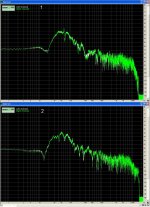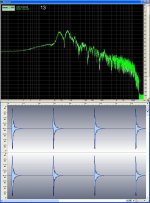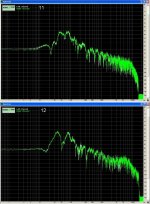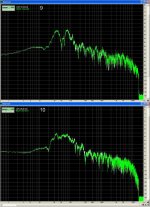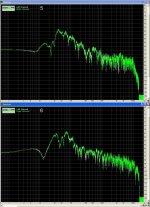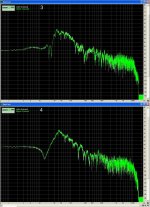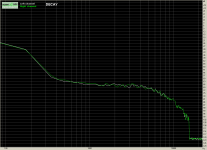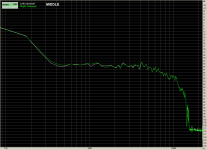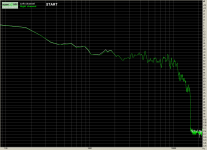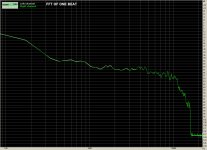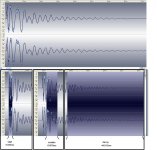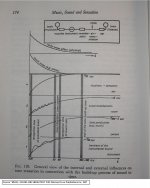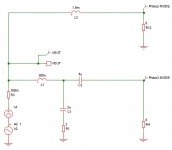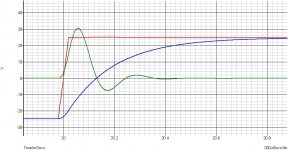So then you are arm chair expert, no more and no less.If I were doing hardware ABX, I would probably use the methods described in the classic Lipshitz/Vanderkooy papers or the systems used by Toole and Olive.
Dan.
So then you are arm chair expert, no more and no less.
Dan.
No, I have no particular expertise in armchairs.
So you have never been subject to hardware ABX testing ?.No, I have no particular expertise in armchairs.
Dan.
You made my day😀No, I have no particular expertise in armchairs.
So you have never been subject to hardware ABX testing ?.
I'm not sure how you could ABX test armchairs.
But if you want to ABX hardware components, there's a lot of good ways to do that- I've suggested two excellent sources. And I've used the Lipshitz/Vanderkooy protocols back when I was convinced that they were flannel-eared idiots and wanted to prove them wrong- it's easy to make an ABX box of your own, and if you build yourself, you aren't limited to the ABX test format.
These days, we have much better ways to do things using software, but that wasn't so in the early 1980s.
No, the maximum value of the the fundamental is not equal to the max value of the square wave. It exceeds it. The ratio is 4/pi. That is why the fundamental carries 80% of the power.wahab said:In the rising hedge of a square you can see that full amplitude is reached from the start and then sustained, it s not difficult to imagine that the max value is sustained thanks to harmonics, the fundamental max contribution to the level occur at pi/2 and 2pi/3, that is, when the fundamental (wich is a sine) reach its maximum values wich are equal to the max value of the sustained part of the signal.
Of course. That is the only valid measure if power dissipation is being considered. As I said, if there is also a limit on displacement (unlikely for a tweeter?) then a bigger tweeter may be needed.You are talking of average amplitude and power.
Don't forget that the tweeter sees a bandlimited signal - all audio is bandlimited. The rise is not instantaneous. The narrow spike of the raw square wave will be rounded off by the bandlimiting.The tweeter will see the full amplitude but during short durations such that average power (and hence level) are very low.
My view (without thinking about it too much) is that a full amplitude LF square wave may be too lenient a test; that is why I said it is a bad test. Heavily clipped or synthesised 'music' might have components more like a 1kHz square wave. That will have much more HF energy than a 20Hz square wave.
Confidence in engineering and confidence in ears are two quite different types of confidence; one is supported by facts, and the other is undermined by facts.Jay said:I think you don't. There's no connection with Civil Engineering there. The point was in the next paragraph. Saying that the relative level of the confidence with anyone's ears (or other skills) would depend on his experience and expertise (fact#1)...
One's ears can mislead. One's assumption too. Some people are better at making assumptions and some people are better at using their ears.
I apologise if I have confused you with someone else, but my recollection is that you have often claimed to be able to make reliable judgements about sound at levels of sensitivity which others find difficult to believe.An example of your wrong assumption (and frequent generalization). There is simply no way you can judge if you are more conservative than I am or not regarding our own ears.
Far from it. If I think I have heard something, but in fact have not, then my level of confidence depends on the extent to which I believe what my ears appear to tell me. If, in spite of appearing to hear something, I decide that I have not heard it then where is the overconfidence? It is those who regard their ears as trustworthy and reliable who are in danger of oveconfidence.If you ever (or frequently) made a mistake regarding your ears, it doesn't tell that your ears are bad. It only tells that you are OVER-CONFIDENT with your ears.
If there is no difference, why do you appear to object to some of what I say? I am not saying anything surprising or controversial; most would agree that what I say is blindingly obvious and well-supported by facts.So where is the difference? If you think there is difference, I think the difference is in your head (your assumptions and generalization).
On switchers: when I was proposing a system that would handle high levels, I suggested an array of mercury displacement relays for the loudspeakers and amplifier outputs. When Olive began to realize how many of these clunky relays would be needed, abruptly the cost-no-object system no longer fit that description.
One guy who was under consideration for assisting in the project had come from the showroom switcher company Audio Authority. I lost about 6dB of respect when he said he would be concerned about "film noise", a term I suspect he made up for the occasion of the interview.
As mentioned earlier, I don't know what they wound up with for level-adjusting presets, or the details of what weighting function is applied when determining the level settings for specific loudspeakers under test. I guess I could have inquired of Sean last Sunday, but it didn't occur to me for some reason, while we were drinking a 2010 Chateau de Beaucastel Chateauneuf du Pape and other Rhones and Rhone Ranger wines. It was not a blind tasting, although with even more wine...
Toole and Olive and I agreed, however, that a switching system of whatever sort would always be blamed at some level for any aberrations, regardless of how "blameless". As far as I know the only switching now is done for loudspeakers, which I believe have individual power amplifiers whose line-level inputs are selected while the single units are pneumatically moved into listening positions behind the screen.
One guy who was under consideration for assisting in the project had come from the showroom switcher company Audio Authority. I lost about 6dB of respect when he said he would be concerned about "film noise", a term I suspect he made up for the occasion of the interview.
As mentioned earlier, I don't know what they wound up with for level-adjusting presets, or the details of what weighting function is applied when determining the level settings for specific loudspeakers under test. I guess I could have inquired of Sean last Sunday, but it didn't occur to me for some reason, while we were drinking a 2010 Chateau de Beaucastel Chateauneuf du Pape and other Rhones and Rhone Ranger wines. It was not a blind tasting, although with even more wine...
Toole and Olive and I agreed, however, that a switching system of whatever sort would always be blamed at some level for any aberrations, regardless of how "blameless". As far as I know the only switching now is done for loudspeakers, which I believe have individual power amplifiers whose line-level inputs are selected while the single units are pneumatically moved into listening positions behind the screen.
As a question, do you know how a drummer get a hard attack out of the bass drum..?.
This is from a kick drum comparison.
13 different kick drums playing four single beats each
George
Attachments
Sadly Floyd tends to drink his wines too young, for fear that they will go bad. He was concerned that a 2005 Dierberg Pinot Noir in magnum would be found defective, despite my reassurances to the contrary.2010? Seems awfully young. Out of '89 and '90?
Contrast this with another friend who errs in the opposite direction, and doesn't even have temp-controlled storage in his cellar. Somehow the notion of installing equipment not available when the large house was built in the 20s galls him and his wife, who spent years meticulously restoring the place. To each his own.
That s a FFT and per defintion you cant use this to prove your (lack of) point unless you can psuchologically visualize the sum of the amplitudes, wich i doubt.
What is the level of the signal during the first millisecond once you have added all thoses hamonics amplitude values..?..
In the rising hedge of a square you can see that full amplitude is reached from the start and then sustained, it s not difficult to imagine that the max value is sustained thanks to harmonics, the fundamental max contribution to the level occur at pi/2 and 2pi/3, that is, when the fundamental (wich is a sine) reach its maximum values wich are equal to the max value of the sustained part of the signal.
wahab please note that our brain needs considerable time >50 milliseconds to perceive tone, color and loudness. 🙂
That said, I took the recording of #1 kick drum, isolated the first beat and split this first beat into start, middle and decay sections.
See the FFTs of these beat slices.
Resolution and LF extension are not good (512 points due to small duration of the first slice).
The point is the balance btn the frequency components.
George
Attachments
No, the maximum value of the the fundamental is not equal to the max value of the square wave. It exceeds it. The ratio is 4/pi. That is why the fundamental carries 80% of the power.
Granted but it carries 80% of the average power, not of the instantaneous power over all parts of the curve.
Of course. That is the only valid measure if power dissipation is being considered. As I said, if there is also a limit on displacement (unlikely for a tweeter?) then a bigger tweeter may be needed.
You are thinking that a 1W amplifier that has duty cycle of 1% can be used for 100W peaks, at least that s what you said amount to.
As said the tweeter will see the full amplitude even if it s short duration, if it s full peaks that last 1ms with a 100W amplifier this will be 0.1W on average but when the peak occur the full voltage swing is necessary.
Don't forget that the tweeter sees a bandlimited signal - all audio is bandlimited. The rise is not instantaneous. The narrow spike of the raw square wave will be rounded off by the bandlimiting.
My view (without thinking about it too much) is that a full amplitude LF square wave may be too lenient a test; that is why I said it is a bad test. Heavily clipped or synthesised 'music' might have components more like a 1kHz square wave. That will have much more HF energy than a 20Hz square wave.
Thing is that some freqencies that are sent to the woofer will be lacking in the tweeter to reduce the amplitude of some harmonics, i guess that you know that functions that can have opposite signs are summed, so even with a limited bandwith peaks in the tweeter can exceed the square peak level, the result is a rounded peak in the tweeter in respect of the previous pic i posted.
A simple filter with the time and the frequency responses, signal is 50Hz/50V pp :
Attachments
That s well summarized.
The pic below is a 50Hz/50V pp square wave in red and the corresponding signals with a 2 way 6db/octave filter (one inductance and a cap..) and 8R loads, we can see the action of the filter in the time domain.
Given that amplitude of the harmonics decrease with frequency the picture would be no different if i had restricted the square wave to harmonics up to 10KHz.
Ok, but how about some numbers? You are basically saying that musical signals could all line up in proper phases so that a bunch of odd harmonics along with their f1 tone could make a square wave that would then stress a tweeter amp as much as a woofer amp (assuming equal SPL sensitivities)?
How about if all those same harmonics lined up so that they instead peaked at the same instant, seems just as fair of an "it could happen!" scenario. In a square wave, the level of each harmonic is (4/pi)*1/TheHarmonicNumber, so sum up all 100 terms from 20Hz up to 20kHz, all peaking at the same instant and you get a little over 5.2 times the square wave's amplitude, now the recording needs about 14dB extra headroom to handle that possible signal. And the woofer amp needs to be 4.76x -- 13.5dB, 22.6x as much power! -- to handle that signal if it had the harmonics aligned that way (the tweeter in that case only needs to be about 0.2x as much power as with the square wave, though).
Ok, so that's really ugly for the needed recording headroom (hope it's not vinyl, wouldn't leave much!). And for the needed woofer amp. But, hey it's possible...
But as I tried to point out before (in relation to peak current requirements), the reality of these kinds of events actually occurring and their actual severity can be MEASURED with actual music signals, and without crazy equipment... a triggered oscilloscope with persistence is about all that is needed. You don't need to design amps for the worst mathematical occurance you could possibly conceive of. You can do a survey of real situations to see what would be really needed for music (and no one cares whether a moving coil cartridge playing over a nick in vinyl plays back that nick with full fidelity, btw, so.... music only).
This is from a kick drum comparison.
13 different kick drums playing four single beats each
George
My question was about the mean to get a hard attack with a kick drum, neverless a drum is only part of an abrupt orchestral sound.
https://en.wikipedia.org/wiki/Orchestra_hit
(the tweeter in that case only needs to be about 0.2x as much power as with the square wave, though).
0.2x on average...
That being said, and considering the rest of your post, i would find logical that the speaker system can reproduce full power at any frequency, even if the higher ones have low average power...
The problem doesnt exist with a passive system because the filter does the time domain discrimination and that a single amplifier is hence necessary but with an active system this wont work as full amplitude is required even for the tweeter, and even if it manifest through low duty cycles.
Last edited:
Confidence in engineering and confidence in ears are two quite different types of confidence; one is supported by facts, and the other is undermined by facts.
Agree. But my point was not about that.
I apologise if I have confused you with someone else, but my recollection is that you have often claimed to be able to make reliable judgements about sound at levels of sensitivity which others find difficult to believe.
I think you are correct (more or less). Note that in real life I tend to under-estimate my capability. That's why I often surprise to find out the positive 'reality'.
What you see/recollect is not my over-confident. It's my experience/skill. In this site you can search on Foobar ABX test pioneered by PMA and others. Am I wrong when I found out that I can do 10/10, 20/20 or may be 100/100 because for me the difference is so real, while others can't? I told people what to listen for, and in what time segment of the recording, but why people still cannot hear what I hear?
You might have asked or pushed JC to prove his assumptions in an ABX and he might have refused. Me? I offer you my ears so at least you can test your assumptions about human audibility thresholds (but people often ask me to do it myself as if I'm the one who need to prove it to myself).
I don't know if I can hear the Bybee effect or if it is audible or not, but not like you I'm open minded regarding to that. (And honestly, with my skill and knowledge on listening, I would guess that JC was right).
Far from it.
You don't understand the concept/logic.
If I think I have heard something, but in fact have not, then my level of confidence depends on the extent to which I believe what my ears appear to tell me. If, in spite of appearing to hear something, I decide that I have not heard it then where is the overconfidence?
Relativity. I'm not comparing you with me or any other samples...
If you tend to think that you can score 5 but in reality you score 3, then you are over-confident in your own capability...
If I tend to think that I can score maximum 7 but in reality I score 12, then I tend to under-estimate my own capability.
It is those who regard their ears as trustworthy and reliable who are in danger of oveconfidence.
Like I said before (see my previous "4 quadrants"), I think it is more about human's personality. You can ask your wife or colleagues if you're not sure about your own 🙂
If there is no difference, why do you appear to object to some of what I say? I am not saying anything surprising or controversial; most would agree that what I say is blindingly obvious and well-supported by facts.
I might not object on the technical parts. I disagree when I see that you are generalizing, making unnecessary assumptions, or being not-open-minded.
0.2x on average...
No, peak. Do a spreadsheet -- with a 1kHz crossover, the sum of components below 1kHz is 4.765, the sum of those above 1kHz is 0.439. (all amplitudes normalized to the square wave's amplitude)
That might be logical (but still isn't) only if said speaker system were to be a function generator not a music reproduction system. If it's for music or voice, the only logical way to deal with it would be to see what kind of peak signals result with music or voice and design for that, with a little margin.I would find logical that the speaker system can reproduce full power at any frequency, even if the higher ones have low average power...
Actually, even for the "acoustic function generator" speaker system, the spreadsheet analysis seems to indicate that the woofer amplifier would actually still need to be about 3 times as powerful as the tweeter amp -- the equivalence you refer to with square wave phased signal components only occurs when they make the fastest rise time, but they could be just as likely phased to peak such that the woofer amp has to be much bigger. But not so much for the tweeter amp (if we bandlimit to 20kHz and use a 1.1kHz square wave, the tweeter only needs 2.65x the square wave amplitude).
Last edited:
No, peak. Do a spreadsheet -- with a 1kHz crossover, the sum of components below 1kHz is 4.765, the sum of those above 1kHz is 0.439. (all amplitudes normalized to the square wave's amplitude)
You can see on the sim i posted that the high pass filter cut severly the highs, yet the amplitude at the tweeter reach the peak voltage :
http://www.diyaudio.com/forums/loun...ch-preamplifier-part-ii-8514.html#post4786134
I could use an even more agressive attenuation it wouldnt change significantly the picture.
- Status
- Not open for further replies.
- Home
- Member Areas
- The Lounge
- John Curl's Blowtorch preamplifier part II
